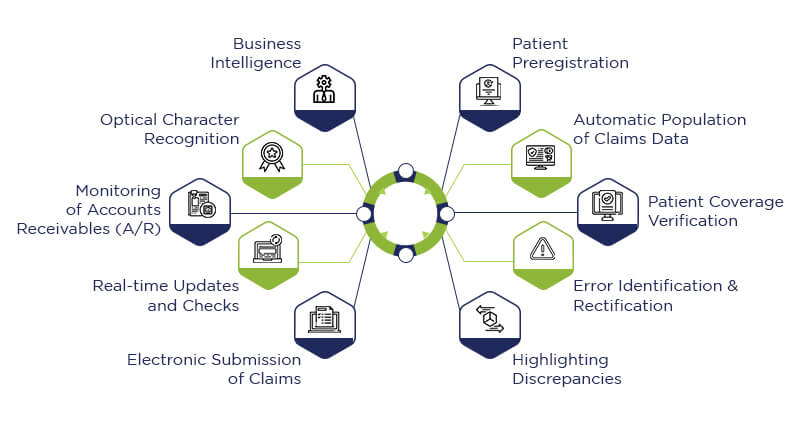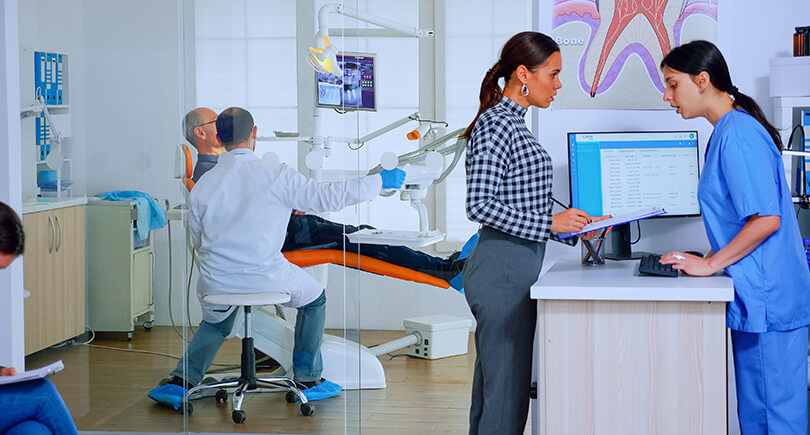As the world continues its fight against Covid-19, healthcare organizations are looking for innovative ways to mitigate recent challenges. From telemedicine to remote access, software solutions offer answers to address value-based caregiving. Among other things, medical billing processing needs to be designed to address the need of the hour. As the healthcare panorama significantly shifts, medical billing solutions must be built to adapt to the requirements of remote caregiving, telehealth, and updated safety norms.
mHealth is now the center point of all caregiving strategies. More than a stop-gap arrangement that addresses healthcare provider needs during the pandemic, healthcare automation is currently envisioned as the future of healthcare. Custom healthcare solutions and integrated care management are consistently aligned to offer automation in hospitals. As caregivers focus on innovative ways to provide care for patients, medical billing solutions need to fall in line to provide automated and hassle-free billing solutions. Medical billing codes are frequently updated, medical coding automation can be integrated into medical billing automation through automated medical coding solutions.
Features, such as front-edge software and web-based solutions, are a given. However, customization and automation in medical billing can no longer be undermined in their utility. Automated medical billing software can considerably boost overall billing systems, minimize errors in integrated healthcare systems and accelerate claims processing. With flexibility and agility as the top priority, the automated medical billing process includes physician billing solutions, HIPAA compliance solutions, etc. Challenges must be identified for a seamless workflow in automated health systems, and medical billing systems software features can be incorporated accordingly.
Current Challenges Faced with Billing Systems in Healthcare
The medical billing process is constantly evolving in healthcare. With a focus on patient convenience, the current reimbursement models take on more risk. This takes the pressure away from the patients and places it on the reimbursement agencies that need to adhere to stricter timelines and protocols. There are three distinct avenues within health billing systems – financial, technical, and operational. The financial department deals with accounts receivable, collection rates, and denials. The technical side deals with systems, processes, and interactions. Finally, the operational side looks into staff matters, communication with vendors, and the overall workflow. Therefore, billing systems for healthcare provider network come with multiple pain points. They are as follows:
- Limited resources dedicated to the revenue cycle
- Lack of expertise in the claims adjudication process
- Strict timeline demands
- Evolution and changes in reimbursement strategies
- The rise in billing costs
- Organizational incompetence
- Lag in responses
- Disparate standards and inefficiencies
Futuristic Features of Automation in Medical Billing

1. Patient Preregistration
This step is a crucial component of automation in medical billing. The billing workflow is significantly optimized through an accurate and consistent system of patient preregistration. The onboarding and inflow process of medical records management allows patients to experience a higher level of satisfaction through reduced wait times. Additionally, with a purview of patient history, insurance eligibility, and Medicare provider enrolment, this feature of patient engagement systems provides overall efficiency in the software for medical billing. As preliminary information is already collected at appointment scheduling, this preregistration process can reduce vulnerabilities to billing errors. Medical billing software companies can incorporate an appointment scheduling app.
2. Automatic Population of Claims Data
This feature of automated health systems is a must-have and eliminates the requirement for manual intervention of data reentries. Through automation in healthcare, systems are equipped to generate the data based on initial entries automatically. Thus, the data is organically generated and programmed efficiently through clinical data analysis. Claims management services are essential in medical billing reporting to save time and reduce inaccuracies. The many steps involved in healthcare claims management are relatively time-consuming to undertake manually. The medical claims process is an integral part of issuing invoices, and automating medical claims processing creates efficiency and accuracy for billing staff at the healthcare organization. The medical billing workflow is entirely electronic through medical claims processing, and paperless collections ensure streamlined and seamless communications between patients, caregivers, and providers.
3. Patient Coverage Verification
Automation in healthcare and electronic health records are applied to cut down on delays wherein the eligibility of the patient’s coverage can be confirmed electronically, and payment recovery processes can be immediately started. This eliminates the frustrating time lag owed to inactive coverage causing denials. Whether at healthcare scheduling, or post-care payment, hospital management is significantly boosted through flexible payment options. When incorporated into the core functionality of the integrated healthcare system, financial management can considerably increase healthcare payment.
4. Error Identification and Rectification
Medical billing software for billing companies should be able to identify errors during claim submission and offer suggestions for rectifications through healthcare providers solutions. These errors can then be eliminated before submission with automated suggestions. Automated accounting in medical billing software involves medical billing and coding analysis through medical billing codes, medical document management, insurance claims management, accounts receivables, Medicare and Medicaid coverage, and the overall healthcare revenue cycle. Furthermore, error-free invoices and bill generation reduce rejected or denied claims. Electronic bills, automated payment reminders, seamless medical billing, and coding are all features of automated accounting that enhance revenue cycle management. Medical billing companies can consider this a core component of their billing software.
5. Highlighting Discrepancies
Healthcare automation solutions should be capable of highlighting claims that are likely to be rejected or refused through healthcare analytics solutions. This will enable faster problem-solving and increase efficiency. Based on past inputs, automated health systems can predict claims that are potentially those which could be denied. With medical automation, prioritization becomes much easier through this feature, with immediate attention demanded towards certain areas, such as pending matters. The healthcare revenue cycle management process is instantly uplifted through fewer errors, which translates to higher profits.
6. Electronic Submission of Claims
An automated health system comes with the capability to create, verify and submit claims electronically through electronic data exchange. This erases the need for manual paperwork. Accessibility is increased through electronic documentation and records. Medical coding and billing is a process that is prone to consistent errors due to the constant updates and changes in medical codes. Revenue cycle management is adversely affected through rejected or denied claims, usually resulting from inaccurate coding. Medical billing companies are spared a heavy burden when the software is equipped with efficient and accurate coding methodologies.
7. Real-time Updates and Checks
High-performance automated health services software provides real-time access to current and past claims, along with areas that need to be checked. Healthcare process automation reduces the need for manual processing. The benefits are much more when the medical billing software has instant and uninterrupted access to the updated patient database through integrated health systems. Medical billing companies must ensure that EHR/ EMR access is given to the medical coding and billing department to boost the revenue cycle for healthcare. Finally, it allows access to medical records, insurance eligibility, Medicare coverage, prescriptions, medication, etc. Finally, professional claims can be adjudicated in real-time through interactive, transactional experiences through cloud computing in healthcare.
8. Monitoring of Accounts Receivables (A/R)
Automating healthcare processes create the ability, within a medical automation system, to provide access to accounts and pending matters, thereby reducing costs related to policy and medical claims. Additional features include tracking of receivables and fraud detection through clinical informatics solutions. Robust reporting technologies allow seamless workflow between caregiving and billing, providing an all-rounded efficiency. Ideally, an efficient methodology is a smart dashboard that interconnects all patient-related information.
9. Optical Character Recognition
Even though automated health care solutions have been prevalent for several years now, medical billing management has constantly evolved to provide higher satisfaction to all the entities involved in the healthcare industry. One such automated healthcare feature is the Optical Character Recognition (OCR), which has high potential in diminishing the possibility of serious errors in coding and claims filing through healthcare interoperability. This is done through efficient scanning of documents, electronic programming, and isolation.
10. Business Intelligence
Simply put, smart physician billing solutions can offer business insights for revenue generation and increment, such as population health management. Healthcare billing software is the primal branch of healthcare that generates revenue for the organization. Therefore, to maximize profits, business intelligence capabilities are a must in billing software for healthcare. Whether it’s mobile functionality for telemedicine tracking, information capturing, and rendering, overall business assessments increase the power of your software for medical billing.
Conclusion
The strengths of healthcare billing solutions are determined over multiple factors. Physician billing companies can increase functionality through automation in medical billing to enhance patient satisfaction, revisits, and overall revenue generation. The trick to success lies in ensuring that your billing and coding software is embedded with features that will satisfy the evolving needs of healthcare. Patient billing software with a user-friendly interface and the features mentioned above is a sure-shot success model toward increasing overall profits. When closing in on medical billing software, it would be prudent to choose one that requires minimal training of medical billing staff and can be easily accessed across the board. Finally, a robust solution requires a stellar support offering through phone, web, and email channels. Training documentation is another handy tool for continual access by medical staff. If your chosen software adheres to all the features mentioned above, you can rest assured of billing success in the current and future scenarios.
OSP is a trusted software development company that delivers bespoke solutions as per your business needs. Connect with us to hire the best talents in the industry to build enterprise-grade software.

How can we help?
Fill out the short form below or call us at (888) 846-5382
Looking for software solutions to build your product?
Let's discuss your software solutions for your product in our free development acceleration call!
Get In Touch arrow_forwardDiscuss Your Project Handover with a team of expert Book a free consultation arrow_forward
About Author

Written by Riken Shah linkedin
Riken's work motto is to help healthcare providers use technological advancements to make healthcare easily accessible to all stakeholders, from providers to patients. Under his leadership and guidance, OSP Labs has successfully developed over 600 customized software solutions for 200+ healthcare clients across continents.

















